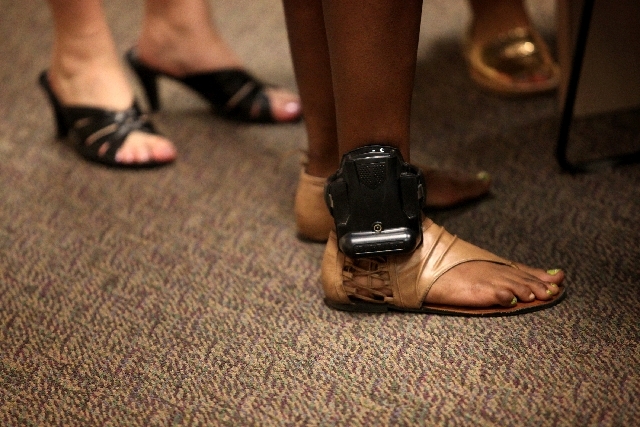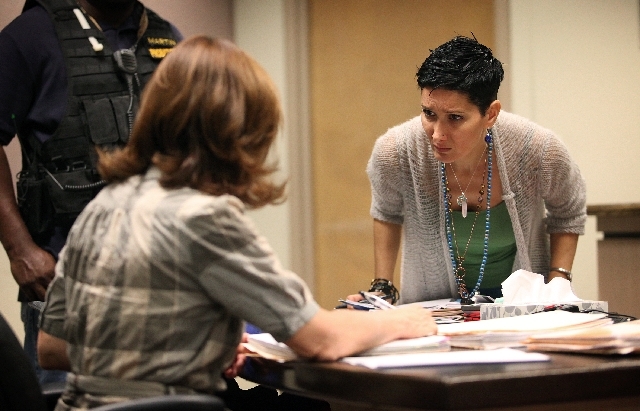‘Survival sex’ continues abuse cycle
Pretty polka-dot bows on top of heads, GPS monitors on the ankles.
Teenagers having babies, then leaving them at home with grandma so they can make money on the streets, in motel suites.
An abusive boyfriend-turned-pimp dropping puppies from bridges to get young girls to work for him.
Incongruous scenes, indeed.
Yet these are just a few of the stories you’re likely to hear when you spend time in Judge William O. Voy’s court at Clark County Juvenile Justice Services.
In the world of sex trafficking, where victims often are willing accomplices, Voy’s court is perhaps the only place in Las Vegas to find true victims — those too young to know any better.
Every Wednesday morning, tears flow freely as probation officers and public defenders alike hand out tissues. As many as 100 girls, ages 12 to 17, pass through Voy’s courtroom each year, and up to 60 percent are from Nevada.
Most were arrested by undercover officers along Boulder Highway, on the Strip or in casinos.
While most could be charged with crimes related to prostitution, Voy and county prosecutors long ago decided not to pursue charges that could haunt a girl for life.
Even if her case is sealed, there’s always that chance it could get out, adding still another permanent scar to go with the other marks from bad parenting, desperate poverty or drug addictions.
Consequently, the charges are downgraded to violating curfew.
“They’re not criminals. They haven’t committed any crimes,” Voy said of the much lower charge. “I tell them to remember that fact when they’re filling out job applications. They haven’t committed a crime; it’s ‘a delinquent act.’ ”
Voy has few choices in the cases that come before him: He can order therapy, offer temporary housing or make the girl a ward of the state. But those approaches are short-term, temporary fixes because there are legal limits to how long the girls can be detained.
For six years, Voy, 53, has seen it all, heard it all, done as much as he can. He hopes someday to build a safehouse for the victims, but he has had a hard time raising money.
Meanwhile, those who care try to fill the void.
One is Esther Brown, a children’s advocate for The Embracing Project. The nonprofit group takes a few kids out of Sin City for a spell to see the world and meet kids who have it even worse, such as child soldiers in Uganda.
At the very least, she introduces the kids to the concept of gardening, or urges them to record their feelings in a diary. Like the alcoholic struggling with addiction, the first step is to acknowledge that a problem exists, even if it’s not completely within their control.
The sense of helplessness is intense as Brown watches some of the girls return to abusive boyfriends or pimps who beg them to have sex for money “if you love me,” because bills are coming due or a drug habit must be fed.
She compares the plight of the girls to the surge of public awareness of domestic violence two decades ago.
“People will say, ‘Well, if things are that bad, then why don’t they just leave him? Why do they keep returning?’ ” says Brown, a fixture in the children’s courtroom.
Then she answers the universal question: “The girls think that he’ll change, that then things will be different; and they try to convince themselves of that, even though it won’t be.”
And so the cycle continues, and the girls return to the very ones who are abusing them, pimping them out. Sometimes, they feel it’s the only place they can return in the absence of any help.
Public defender Susan Roske is another advocate. She said some of the girls are engaging in “survival sex.”
“So much of this is psychological,” Roske said. “It’s a lot like Stockholm syndrome. They really believe that these guys are their boyfriends, and that they truly love them; and once they create this love bond, they convince them to rent out their bodies, and if they don’t, they get violent, and they tell them, ‘You’re nothing but a “ho,” ’ and, ‘Nobody is ever going to love you, so do what I say.’ ”
But exactly how did they get into the life?
For two months last year, UNLV sociology department surveyers spread out across the city to interview nearly 100 girls and women between the ages of 14 and 24 to try to find out.
Researchers learned that the vast majority had never entertained the notion of selling themselves until a boy or man from some passing car barked it out to them, then did a quick U-turn.
Usually, it was a male who offered them protection and regarded them as “sugar mammas,” said Brooke Wagner, one of the student researchers who is now an assistant professor at Wittenberg University in Ohio.
Some of the young prostitutes said their pimps were not abusive. Less than half said they had tried meth, crack or heroin, and those using drugs at all were most likely to use marijuana.
But always, Wagner said, there was “some form of abuse at home that either made them run away or turn to the streets.”
And, she said, there’s always a ready customer: “At the core, the issue is the demand for the product.”
Aaron Hansel, the pastor at the Dream Center, an offshoot of the International Church of Las Vegas, said it’s time to change how men think.
“We need to teach men how to be better fathers, better husbands, better people,” Hansel said.
He has even started a program in which families gather together and talk about it in their living rooms.
Voy tries to believe. He puts great stock in such efforts, but he’s pragmatic.
“The demand is always going to be there. It’s always going to exist. But that doesn’t mean we can’t try and stop it. The trick is to stop everything before it starts, obviously. And we can pour as much money into the resources as possible, but in the end it all starts at the home.
“Our hands are tied on that one.”
Contact reporter Tom Ragan at tragan @reviewjournal.com or 702-224-5512.





























